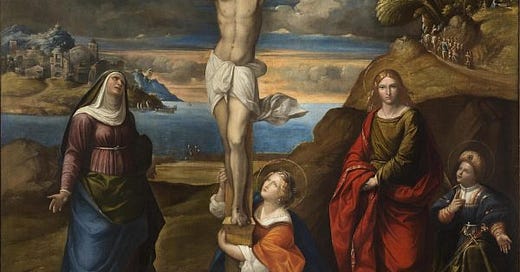It’s Friday in Lent so it seemed appropriate to look at another sort-of genre (more accurately a topos) of Middle English verse, poems about Mary at the Foot of the Cross. Call the subject a perennial favorite down at the scriptorium.
The poems themselves vary greatly in length, metre, structure and the like. The direct involvement of the Blessed Mother in the Passion clearly, and quite rightly, sent our devoted medieval poets and scribes into a frenzy. Nearly too much for a good monk to bear. I have the impression, and it is only an impression mind, that some of the themes which crop up again and again in devotional verse of all varieties, such as Jesus being the fruit of Mary and crucified Jesus being hanging fruit, get a chance to spend some time together in these poems, at least by inference.
No one knows who, precisely, composed these poems or exactly when. We do know that these poems were composed, then altered / corrected / adapted by scribes, over indeterminate periods of time and that our ideas of originality would be alien, and a tad prideful, to the medieval scribe. One may, nevertheless, get a sense of matters coming together and building up to the big finale, as it were, when reading these poems in bulk. I would suggest it not too taxing upon the imagination to surmise that poets, over time, working in the same largely stable devotional “culture,” following the same liturgy, would wind up pointing in the same general direction, so to speak, in their verse.
The first two poems are in the voice of the Blessed Virgin alone. The Passion, it is said, held the “medieval mind” so tightly because the Lord shared their human suffering, of which they had plenty. It gets gory at times, the Catholic physicality of it. The following poems are brief and clever with the language. Given the opportunity to fill the Blessed Virgin’s head with thoughts, the same applies to Mary as it does to Jesus: she suffers the agony of a real mother facing her child’s horror and her own. She bargains in the first, referring to Jesus in purely human terms:1
Why have ye no reuthe on my child?
Have reuthe on me, ful of murning,
Taket doun on rode my derworthi child,
Or prek me on rode with my derling.
More pine ne may me ben don
Than laten me liven in sorwe and schame;
Als love me bindet to my sone,
So lat us deyyen bothen i-same.
Mary now laments her loss and her purely earthly plight, abandoned by her son and left with John:
"Womman, Jon I take to thee
Instede of me thi sone to be."
Allas, wo sal myn herte slaken?
To Jon I am towarde taken;
Mi blisful sone me hat forwaken,
And I have no mo.
Wel may I mone and murning maken,
And wepen til myn eyne aken.
For wane of wele my wo is waken,
Was nevere wif so wo.
Many of the poems, not least the very long ones, consist of a dialogue between Mary and Jesus on the Cross. In what follows there is a quick summary from Mary (put me up there on the cross instead and stop breaking your mother’s heart) followed by Jesus’ reply. Note how Jesus still speaks to Mary like a real son – come now, mom, you’re upsetting me – and doesn’t get too heavy-handed with the bigger picture at the end:
"A Son! tak hede to me whas sone thou was,
And set me uppe wyt thee on i crosse.
Me her to leve, and thee thus hense go,
Yt is to me gret kare and wo.
Stynt now, Son, to be harde to thi moder,
Thou that ever was god to all other."
"Stynt now, Moder, and wepe no more;
Thi sorow and thi dyssesse grevysse me fule sore.
Thou knowyse that in the I tok mannys kynde,
In hyt for mannys syne to be the pynde.
Be now glade, Moder, and have in thoghte
That mannes hel is fondyn forwake, that I have soght.
Thow salt noght now kare what thow salt done;
Lo! Jone, thi kosyne, sall be thi sone."
Then there are the prayers. This is almost painfully cute but is more than saved by the image of the Blessed Virgin weeping on her Son’s feet:
Upon my ryght syde y me leye;
Blessid lady, to thee y pray:
For the teres that ye lete
Upon yowre swete sonnys feete,
Sende me grace for to slepe,
And good dremys for to mete,
Slepyng, wakyng till morowe daye bee.
Owre Lorde is the frwte, oure lady is the tree,
Blessed be the blossome that sprange, Lady, of thee.
In nomine Patris et Filii et Spiritus sancti.
Amen.2
I shall look into some more Calvary-based verse for next Friday. In the meantime, gentle readers,
Keep the faith,
Peregrinus
For unfamiliar vocabulary, please see Middle / Early Modern English Glossary in the “Reference & Guides” section of the Peregrinus page.




